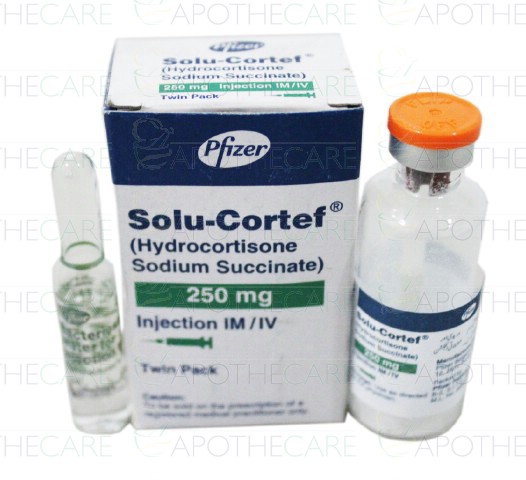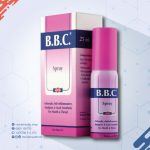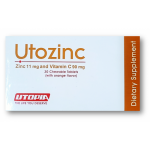
Solu-Cortef
(hydrocortisone sodium succinate)
1. NAME OF THE MEDICINAL PRODUCT :
SOlu·Cortef$ 100 mg powder and solvent for solution for injection
2. QUALITATIVE AND QUANTITATIVE CDMPOSITION :
100 mg powder: One vial contains as active agent hydrocortisone sodium succinate which is equivalent to 100 mg
hydrocortisone. When 100 mg powder is dissotved with the solvent (2 ml) provided in the pack, the resuhing concentration is
SOmg/ml. For exciplents, see section 6.1.
3. PHARMACEUTICAL form :
Powder and solvent for solution for injection
Description of all products: white powder.
4. Clinical particulars :
4.1 Therapeutic Indications
As a physiological supportive measure in prophylaxis and treatment of conditions like adrenal failure and shock, in connection with surgery in risk patients, in severe traumas, in patients who have received or are receiving hydrocortisone or cortisone treatment (emergency surgery, surgery on the adrenal gland, severe injuries, severe generalized infections) and in Addison’s disease (severe generalized infections, emergency surgery, traumas). Sudden hypersensitivity reactions (status asthmaticus, allergic drug reactions), septic generalized infections (meningococcal meningitis, Waterhouse-Friderichsen syndrome), certain immediatelylife-threatening conditions associated with potentially unlreatable shock).
4.2 Posology and method of administration
Solu-Cortef® may be administered by intravenous injection or lnfusion or by intramuscular injection. Intravenous injection is the recommended method in urgent emergencies. Once the emergency has passed, a transfer to a k>nger-acting injection preparation or an oral preparation should be considered. The standard dose is 100 mg hydrocortisone. If no adequate reaction is achieved 15 to 30 minutes after the intravenous administration, or somewhat longer period of time after intramuscular administration, the patient may be administered a further dose of 50 to 100 mg Solu-Cortef181 after 1, 3, 6 and 10 hours. Treatment of shock conditions requires a higher dose, 150 mglkg, by a stow intravenous injection. In general, high-dose corticosteroid therapy should be continued only up to stabilization of the patient’s condition- usually not beyond 48 to 72
hours. The dosage to children in serious conditions should be determined on the basis of severity of the condition rather than the
child’s body-weight and age. Solu-corteMl should not be given at doses lower than 25 mg. Parenteral therapy should be replaced by oral glucocorticoid therapy (e.g. Madrol) as soon as possible.
4.3 Contraindications
Systemic fungal infections. Known hypersensitivity to the active substances of the preparation. Relative contraindications of
intravenous and intramuscular hydrocortisone therapy are herpes simplex keratitiS, sudden psychoses, Cushing’s syndrome,
gastroduodenal ulcers, vaccinia and varicella. Great caution is advised in all parenteral and oral glucocorticoid therapy if the psychosis, active tuberculosis, renal injury or susceptibility to thrombophlebitis.
4.4 Special warnings and special precautions for use Precautions :
Patients receiving corticosteroid therapy should be given a higher dose of a rapidly·acting corticosteroid than usually before a stressful sffiJation as weN as during and after it. Patients who are exposed to severe stress after corticosteroid therapy should be observed carefully to detect development of adrenal failure.
Corticosteroids may mask some signs of infection, and new infections may appear during their use. The use of ccrtlcosteroids may impair resistance and complicate localization of infections. Occurrence of Infections with any pathogen may be associated with the use of corticosteroids either alone or in combination with other immunosuppressive agents that affect cellular immunity, humoral immunity, or neutrophil function. Such infections may be mild, but can also be severe, even fatal. In high-dose corticosteroid therapy the rate of occurrence of infectious complications increases.
Hypematremia, elevated blood pressure, increased salt and water retention in the body and increased potassium excretion may occur if high-dose hydrocortisone therapy needs to be continued beyond 48 to 72 hours. In such a case it may be advisable to replace Solu·Cortef® with another corticosteroid preparation (e.g. a preparation containing methylprednisolone sodium succinate) which causes sodium retention only little or not at all. Dietary salt restriction and potassium supplementation may be necessary. All cortlcosterolds increase calcium excretion. Administration of live, or live, attenuated vaccinee is contraindicated in patients on immunosuppressant doses of corticosteroids. Killed or inactivated vacclnes may be administered to such patients but their response to them may be diminished. Indicated immunizations may be given to patients on non-immunosuppressant doses of corticosteroids.
Although administration of high·dose corticoids may be associated with development of peptic ulcer, it is rare in snort-term therapy. Prophylactic treatment affecting the level of gastric acid may be indicated. Corticosteroids are used to supplement conventional treatment, they do not replace it.
Special precautions :
The use of Solu·Cortef® (hydrocortisone sodium succinate) in active tuberculosis should be restricted to cases of fulminant or disseminated tuberculosis together with appropriate antituberculosis regimen. Patients who have latent tuberculosis or
tuberculine reactivity and require corticosteroid therapy should be observed closely as reactivation of the disease may occur.
During lorq-term corticosteroid therapy, these patients should receive chemoprophylaxis. Because rare instances of anaphylactic reactions (e.g. bronchospasms) have occurred in some patients on parenteral corticosteroid therapy, appropriate precautions are indicated, especially in patients with a known drug allergy.
This preparation contains benzyl alcohol which has been reported to be associated with a fatal gasping syndrome in premature infants.
General precautions :
Caution is advised in the use of corticosteroids in patients with ocular herpes due to the risk of corneal perforation. Psychic derangements, such as euphoria, insomnia, mood changes, personality changes, severe depression or frank psychotic symptoms, may occur in connection with the use of corticosteroids. Emotional instability or psychotic tendencies may be aggravated by the use of corticosteroids. Caution is advised in the use of corticosteroids in nonspecific ulcerative colitis if there is a risk of perforation, abscesses or other pyogenic infection. Particular caution is also advised in patients with diverticulitis, recent intestinal anastomoses, active or latent peptic ulcer, renal failure, hypertension, osteoporosis or myasthenia gravis. Although controlled clinical studies have shown that corticosteroids precipitate efficiently alleviation of acute aggravation phases of multiple sclerosis, their effect on the disease’s natural course or outcome has not been established. According to
studies relatively high corticosteroid doses are required to achieve a significant effect (see Section 4.2).
Use in children :
tone-term daily glucocorticoid therapy may suppress growth in children. Consequently, the use of glucocorticoids should be
restricted to the most severe cases.
4.5 Interaction with other medicinal products and other forms of Interaction
The following pharmacokinetic interactions may be clinically significant: hepatic enzyme-inducing drugs (such as phenobarbital, phenytoin and rifampicin) may increase the clearance of corticosteroids, and in such cases the corticosteroid dose may need to be increased to achieve the desired effect. Drugs such as troleandomycin and ketoconazole may inhibit the metabolism of corticosteroids and thus decrease their clearance. Therefore, the dose of corticosteroid should be titrated to avoid toxicity associated with steroid medication. Corticosteroids may increase the clearance of acetyl salicylic acid used at high doses for long periods of time. This could lead to eased salicylate serum concentrations or increase salicylate toxicity when corticosteroid is withdrawn. Caution is
advised in concomitant administration of acetyl sancsuc-acc and-coeicoeterooe-to patients with hypoprolb!.ombinemia.
The effect of corticosteroids on oral anticoagulants is variable. There are reports of both enhanced and diminished effects of anticoagulant when given concurrently with cortlcosterolds. Therefore blood coagulation values should be monitored to maintain the desired anticoagulant effect.
4.6 Pregnancy and lactation
Animal studies have shown that administration of corticosteroids in large quantities to pregnant animals can increase the risk of fetal malformations. No adequate studies have been conducted on the effect of corttccsteroids on human reproduction.
However, in clinical use, no similar fetal malformations have been found in humans as in animals. If the use of the product is considered during pregnancy or lactation, the potential benefit of the therapy should be carefully weighed against potential risks to the mother, fetus or embryo. Corticosteroids cross the placenta. Infants bom to mothers who have received substantial doses of corticostero’ds during pregnancy must be carefully observed and evaluated toexclude the possibility of adrenaline deficiency. The effect of corticosterolds on labour is unknown. Cortlcosteroids
excreted in breast milk.
4.7 Effects on ability to drive and use machines
Based on the pharmacodynamic and safety profiles of hydrocortisone sodium succinate, Solu-Cortef® is not expecte
affect the ability to drive and use machines.
4.8 Undesirable effects
The following adverse effects are typical of all systemic corticosteroids. Their inclusion in this list does not indicate the
specific event is particularty typical of Solu-Cortef Anaphylactic reaction is a rare adverse effect of parenteral cortcosteroid therapy :
Endocrinology: Suppression of pituitary-adrenal axis; growth retardation in children; development of Cushingoid I impaired glucose tolerance; manifestation of latent diabetes mellitus; increased requirements for insulin or oral hypog/yc agents; menstrual lrreqularities.
Nervous system: Increased intracranial pressure; cerebral pseudotumour; psychic derangements; psychosis. Fluid and electrolyte balance: Sodium and fluid retention; congestive heart failure in susceptible patients; increased I pressure; potassium loss; hypokalemic alkalosis.
Gastrointestinal tract: Peptic ulcer with possible perforation and hemormage; gastric hemormage; pancreatitis; esophe perforation of the bowel.
Musculoskeletal tract: Steroid myopathy; myasthenia; osteoporosis; pathological fractures; vertebral compression fract
aseptic necrosis; tendon rupture (particularty of the Achilles tendon).
Metabolism: Negative nitrogen balance due to protein catabolism.
Eyes: Posterior subcapsular cataract; increased intraocular pressure; exophthalmos.
Skin: Impaired wound healing; petechiae and ecchymosis; thin fragile skin.
Immune system: Masking of infections; manifestation system hypersensitivity react’iOrls, including anaphylaxis; possible suppression of reactions to skin tests. Increases in alanine transaminase (ALT), aspartate transaminase (AST) and alkaline phosphate (APHOS) values have observed following corticosteroid therapy. These changes are usually minor and not associated with any clinical syndr The values have normalized upon discontinuation of therapy.
4.9 Overdose
Acute overdosage with Solu-Cortef$ (hydrocortisone sodium succinate) does not cause any clinical sympt Hydrocortisone Is dialyzable.
5. PHARMACOLOGICAL PROPERTIES :
5.1 Pharmacodynamic properties
Pharmacotherapeutic group: hydrocortisone, ATC code: H02AB09
Mechanism of action: Hydrocortisone alleviates inflammatk1n and symptoms of allergy and impairs immune system. mechanism of action is not fully known.
5.2 Phannacoklnetlc properties
Following intramuscular administration of Solu-Cortef® peak plasma concentrations are achieved in 30 to 60 minutes. J 40 to 90% of hydrocortisone is bound to plasma proteins. Most of it is bound to globulin (transcortin) and only a small p albumin. The free, unbound fraction of the hormone determines the btologicaJ activity whereas the bound fraction functio a storage.
Hydrocortisone is metabolized mainly in the liver. Twenty-two to thirty percent of an intravenous or intramuscular do excreted in urine within 24 hours. Elimination is almost complete in 12 hours. If blood drug concentrations are to be kept and high,the administration interval of the intravenous or intramuscular dose should be 4 to 6 hours.
5.3 Preclinical safety data
There is no evidence of carcinogenicity, mutagenicity or impairment of fertility caused by corticosteroids.
6. PHARMACEUTICAL PARTICULARS:
6.1 List of excipients
Solution for injection: Sodium dihydrogen phosphate monohydrate
Oisodium phosphate Sodium hydroxide
Solvent: Benzyl alcohol and Water for injection solution
6.2 Incompatibilities
Not known.
6.3-Speclal precautions for storage
Solution for injection: Keep at room temperature (15 – 25°C).
Reconstituted solution: Protect from light.
6.4 Nature and contents of container
Pack: 100 mg powder for solution for injection and 2 m! solvent.
6.5 Instructions for use and handling and disposal
Instructions for use
1 )Press the plastic activator to force the solvent into the lower compartment of the vial.
2)Gently turn the vial to dissolve Solu-Cortef®.
3)Remove the protective plastic cap.
4)Clean the surface of the stopper with antibacterial agent.
5)lnsert an injection needle straight through the center of the stopper until the tip is just visible.
Invert the vial and withdraw the drug dose. Solu-Cortef® may also be added to infusion solutions: it can either be injected directly into an infusion line for rapid effect, or it may be mixed with infusion solution for slower infusion. The following solutions are co~ble with Solu-Cortef : syo infusion solution anaT:l mixtUre of these two infusion solutions.
Parenteral drugs should always be inspected visually for particulate matter and discoloration prior to administration, whenever solution and container permit.
Use always only absolutely clear solutions.
Discard any unused solution after 3 days.
Do not use the product after the shelf-life has expired.
Discard expired products in the same manner as drug waste in general.
7. DATE OF REVISION OF THE TEXT :
1 December, 2003
Manufactured by :
E.I.P.I.Co. Egyption International Pharmaceutical Industrial Company
Tenth Of Ramadan City, Industrial Area Bl, P.O. Box: 149 Tenth, Egypt. Under license of pfizer.

